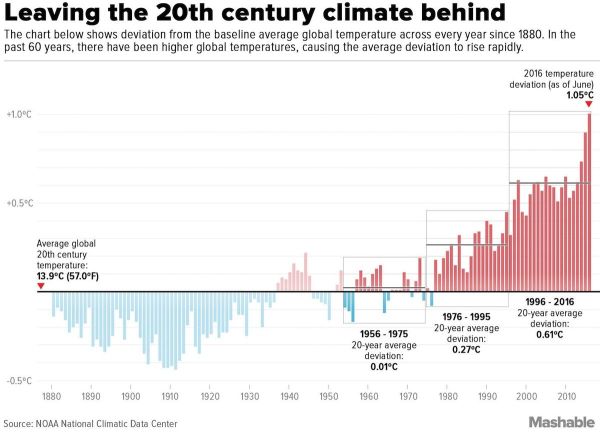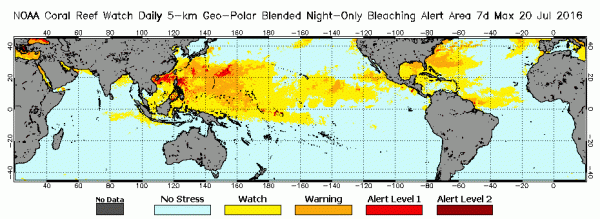El Nino is Basically Over — But this Global Coral Bleaching Event Just Won’t End
21
July, 2016
Back
in 2014, an unsuspecting world was on the verge of a major
global temperature increase. But despite
warnings from scientists like Dr. Kevin Trenberth that deep ocean
warming had sped up and would eventually result in rapid surface
warming,
the big media meme at the time was that global warming had ‘paused.’
Originating in The
Economist,
and swiftly spreading to numerous other news outlets, this particular
blast of bad information fed the public a big helping of false sense
of security.
In 2014
through 2016, maximum global temperatures jumped from around 0.65
degrees Celsius to around 1 C above the 20th-century average. In just
three years’ time, the whole of the Earth’s surface had warmed by
about 0.35 C. This is like cramming all of the warming from 1880 to
1980 into the three-year 2014-to-2016 period. Never before in all of
the global climate record starting in the late 19th century has the
Earth warmed so much in so short a time.
(Huge
jump in global temperatures over the past three years has probably
passed a number of climate thresholds — including temperature
thresholds for key sea creatures like corals. Data Source: NOAA.
Image source: Mashable.)
Global
warming hadn’t paused at all. It was just getting ready to hit the
accelerator.
Global
Heat Spurs Bleaching, Mass Coral Mortality
All
this newly-added surface heat represents a big step up into much
warmer conditions for the global climate. What this means is that
even the coolest months now will probably approximate the
warmest months during the big super El Niño of 1998. Such a large
temperature increase in so short a period means that the world has
likely hit a number of tipping points for geophysical and ecological
harm. One of the most visible of these tipping points involves an
ongoing ecological crisis — a global coral bleaching event.
Perhaps
the most vivid and heart-wrenching example of what is a very
wide-ranging coral mortality situation is the bleaching-related
damage to Australia’s Great Barrier Reef. In a terrible blow to one
of the world’s most stunning natural wonders, about a quarter of
the Great Barrier Reef’s corals have already been killed off — an
event that some scientists say may eventually lead to 100 percent
mortality of the Reef’s corals. (see a related report in The
Guardian).
(Coral
bleaching events like this one in American Samoa during 2015 have
been happening around the world since 2014. It’s a global event
that’s still ongoing despite a turn toward La Niña conditions in
the Pacific. This is the longest global coral bleaching event ever
recorded, and one that could continue into 2017 or beyond. Image
source: Nature.)
The
Great Barrier Reef is not the only reef system to suffer. In fact,
the added heat due to human-forced warming of the atmosphere and
oceans has generated bleaching-induced heat stress and mass coral
mortality the world over. And some of the world’s other great reef
systems, including Kiribati, which
lost 80 percent of its live corals in 10 months,
have been hit so hard it’s doubtful they’ll ever recover.
The
Seemingly Never-Ending Global Coral Bleaching Event
At
issue is the fact that all this added global heat is creating a
situation where reefs bleach year after year and, in some cases (as
was the case with parts of the Great Barrier Reef this year)
even bleach during winter. It’s a coral mass mortality that falls
under the definition of a global bleaching event. But it’s also
happening with an intensity, persistence, and duration that we’ve
never seen before.
Beginning
in 2014 with the big warm-up that preceded the 2015-2016 El Niño,
the present global coral bleaching event is now, according to
NOAA, the
longest-running and the most extensive such event to have occurred in
the modern record.
NOAA notes:
…the current global coral bleaching event is the longest ever recorded. It has affected more reefs than any previous global bleaching event and has been worse in some locales (e.g., Great Barrier Reef, Kiribati). Thermal stress during this event also has caused mass bleaching in several reefs that never bleached before (e.g., northernmost Great Barrier Reef).
(Global
coral bleaching event extent as of July 20 according to NOAA. Note
that sections of bleaching watch and warning conditions now extend
across the northern edges of NOAA’s map, an indication that
latitudinal extent of bleaching is expanding beyond typical ranges
even as bleaching due to rising ocean temperatures appears to be
becoming a near-constant issue for world corals. Image source: NOAA.)
NOAA
had initially forecast that this very-long-duration bleaching event
would end sometime in 2016 as El Niño faded out. However, with
sea-surface temperatures in the equatorial Pacific hitting
the cool side of natural climate variability in the form of La
Niña-like conditions during recent weeks,
and the current global coral bleaching event still going strong, one
has to wonder if oceans have now become hot enough to spur widespread
bleaching at almost any time.
NOAA
now predicts a possible end to the current global bleaching event in
2017, giving the event a four-year duration. But with global
temperatures continuing to warm, what we may be seeing is the start
of an unbroken or nearly unbroken period of expanding coral
bleaching, a time when global stress to corals due to high ocean
temperatures is practically continuous.
Links/Attribution/Statements
Hat
tip to June
Hat
tip to Colorado Bob
Hat
tip to DT Lange






No comments:
Post a Comment
Note: only a member of this blog may post a comment.